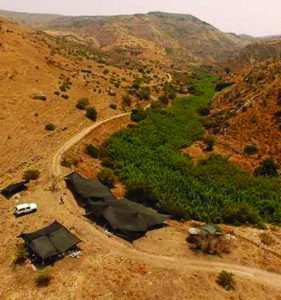
Archaeologists from the Hebrew University of Jerusalem uncovered a prehistoric village, dated around 12,000 years ago, in excavations in the fertile Jordan Valley. The newly excavated village sheds light on the historical shift from foraging to agriculture.

Aerial of excavation site in the Jordan Valley
A series of excavations on site revealed an abundance of human burial remains, flint tools, art manifestations, faunal assemblage, ground stone and bone tools. Surprisingly, the village differs markedly from others of its period in Israel. The findings encapsulate cultural characteristics typical of both the Old Stone Age, known as the Paleolithic period, and the New Stone Age, known as the Neolithic period.
“Although attributes of the lithic tool kit places the site chronologically in the Paleolithic period, other characteristics—such as its artistic tradition, size, thickness of archaeological deposits and investment in architecture—are more typical of early agricultural communities in the Neolithic period,” said Dr. Leore Grosman, from the Institute of Archaeology at The Hebrew University of Jerusalem, who led the excavations.
“Characterizing this important period of potential overlap in the Jordan Valley is crucial for the understanding of the socioeconomic processes that marked the shift from Paleolithic mobile societies of hunter-gatherers to Neolithic agricultural communities,” added Dr. Grosman.
Researchers say that this shift in settlement pattern could be related to greater climatic stability, higher cereal biomass productivity and better conditions for small-scale cultivation. These factors provided the ingredients necessary to taking the final steps toward agriculture in the southern Levant.
Source: Excerpts of an article by The Hebrew University of Jerusalem
Photo Credit: The Hebrew University of Jerusalem
All logos and trademarks in this site are property of their respective owner. All other materials are property of Bridges for Peace. Copyright © 2025.
Website Site Design by J-Town Internet Services Ltd. - Based in Jerusalem and Serving the World.